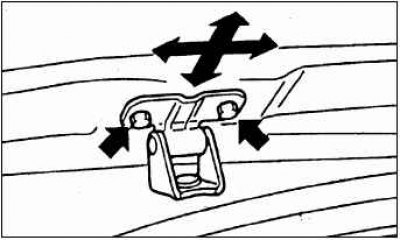
If the gap around the perimeter between the side door and the body is uneven, stick the protective tape on the body around the hinge and on the edge of the door, then use the special tool to loosen the bolts securing the door hinge to the body. When moving the door, adjust the gap between the door and the body so that the gap is the same around the entire perimeter of the door.

If the closed door is not flush with the surface of the body, use the special tool to loosen the hinge bolts on the door and adjust the position of the door so that its surface is flush with the surface of the body.
Attention! Do not apply more than 98 N to the special tool.
Note. If the washers of the door hinge bolts are welded, then remove the door hinge, then use a chisel or cut-off machine to remove the washer weld.
Install the door hinge in place, having previously painted over the damaged area of the hinge with paint from the repair kit or treated with an anti-corrosion compound.

If it is difficult to open and close the door, adjust the engagement of the lock and the door latch by installing additional spacers between the latch and the body pillar and moving the latch either up and down or left and right.
Rear door adjustment

If it is difficult to open and close the door, replace the door lock retainer and the retainer mounting bolts.
Temporarily tighten the mounting bolts, then adjust the engagement of the lock and the door lock latch by moving the lock latch either back and forth or left and right.

After adjustment, tighten the bolts to the specified torque.
Tightening torque: 20–28 Nm.
Note. If the bolt heads are snagging on the edge of the rear door sill trim, use a round file to file where the trim contacts the bolt.

If the gap around the perimeter between the rear door and the body is uneven, loosen the door hinge bolts and adjust the gap by moving the hinges.
 |  |
Adjust the rear door height by turning the door rubber feet. With each full turn of the rubber support, the height increases by approximately 3 mm.
